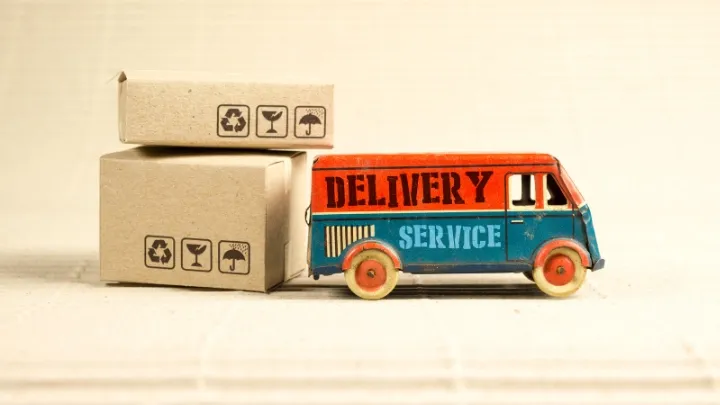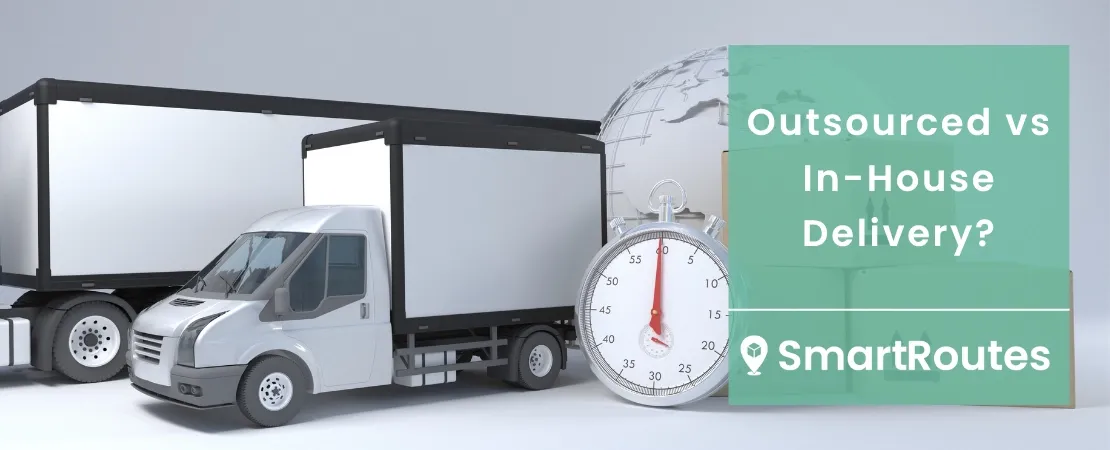In today's fast-paced and highly competitive business landscape, delivering products to customers quickly and efficiently is more important than ever. Whether you are running a small eCommerce store or a large-scale retail operation, your delivery options can have a significant impact on your business's success. Delivery options can affect everything from customer satisfaction to the bottom line, making it crucial for businesses to carefully consider their options.

There are two main options when it comes to delivery: outsourced and in-house delivery. Outsourced delivery involves hiring a third-party company to handle the delivery process, while in-house delivery involves managing and handling the delivery process internally. Each option comes with its own set of benefits and drawbacks, and the choice will depend on factors such as the size of the business, the nature of the products being delivered and the desired level of control over the delivery process.
Outsourced Delivery
Outsourced delivery is a popular option for businesses that want to focus on aspects of the business other than delivery. Third-party delivery services handle the logistics of delivering products to customers, including transportation, delivery tracking, and customer service.
Pros of Outsourced Delivery
Cost-effectiveness: Outsourcing delivery can be a cost-effective option for businesses, as it eliminates the need for them to invest in delivery infrastructure, vehicles, and the associated costs of hiring and training delivery staff. This can help businesses save money and allocate their resources more effectively.
Flexibility: Outsourced delivery offers businesses a greater degree of flexibility in managing their delivery process. Third-party companies can provide customized delivery solutions tailored to the specific needs of the business, allowing them to scale their delivery operations up or down as needed.
Convenience: Outsourced delivery can be more convenient for businesses, as it eliminates the need to manage and oversee the delivery process. Third-party companies handle all aspects of the delivery process, including transportation, delivery tracking, and customer service. This can free up time and resources for businesses to focus on other areas of their operations.
Access to expertise: Third-party delivery companies have a wealth of experience and expertise in managing the delivery process, which can be beneficial for businesses. They have specialized knowledge and tools to optimize delivery routes, reduce delivery times, and improve
Cons of Outsourced Delivery
Less control over the delivery process: When using a third-party delivery service, businesses may not have as much visibility into the delivery process or be able to provide as much customization for customers. This can be frustrating if the business wants to ensure that its product is delivered in a specific way or with certain instructions.
Dependability: If there are issues with the delivery process, businesses may need to rely on a third-party company to resolve the issue, which can be frustrating for both the business and the customer. This can be challenging if the third-party company has different priorities or values than the business, or if the issue is not easily resolved.
Limited branding opportunities: When using a third-party delivery service, businesses may not have as many opportunities to brand the delivery experience. This can be important for businesses that want to provide a consistent and recognizable experience for their customers.
Potential for delivery delays: If the third-party company experiences delays or issues with their delivery network, this can result in delays for the business's customers. This can be frustrating for customers and can damage the business's reputation if it happens frequently.
SmartRoutes Route Planning Software
Streamline your entire delivery process, all from one platform

In-House Delivery
In-house delivery gives businesses complete control over their delivery process. The business is responsible for managing the logistics, routing, and tracking of deliveries, as well as any customer service issues that may arise during the delivery process. This can be a good option for businesses that have the resources and the capacity to handle delivery operations internally. For small and medium-sized businesses, in-house delivery may involve having a few employees handle local deliveries in their personal vehicles. For larger businesses, this may require the establishment of a dedicated delivery team with a fleet of vehicles. In-house delivery can be a significant undertaking for a business, as it requires a significant investment in infrastructure, technology, and personnel.
Pros of In-House Delivery
More control over the delivery process: With in-house delivery, businesses have more control over the delivery process and can ensure that their products are delivered in a specific way. This can be especially important for businesses that sell high-value or sensitive products.
Customized delivery experience: In-house delivery can also provide more opportunities for customization, such as offering same-day or next-day delivery options, as well as personalized delivery instructions like ‘leave my package with a neighbour if I don’t answer the door”.
Faster delivery times: In-house delivery can potentially provide faster delivery times compared to outsourcing, as businesses have more control over the delivery schedule and can prioritize deliveries as needed.
Flexibility: Managing the delivery process in-house can provide greater flexibility in terms of delivery scheduling and routing, as well as the ability to make real-time adjustments to accommodate unexpected changes or delays.
Greater visibility and accountability: By managing the delivery process in-house, businesses have greater visibility into the delivery process and can take steps to address any issues or concerns that arise.
Cons of In-House Delivery
Higher costs: One of the major drawbacks of in-house delivery is the higher costs associated with managing the delivery process. These costs can include vehicle maintenance, fuel costs, insurance, and wages for delivery staff, which can add up quickly and may not be feasible for smaller businesses.
Need for additional resources: In-house delivery also requires significant investment in infrastructure and resources, which can be a challenge for businesses with limited resources or operating on a smaller scale. This can include purchasing or leasing vehicles, setting up a delivery management system, and hiring and training delivery staff. These additional resources use up much-needed time and money to implement.
Logistical challenges: In-house delivery also presents logistical challenges such as managing delivery routes, tracking inventory, and coordinating staff schedules. This can be a complex and time-consuming process that requires careful planning and management.
Limited catchment area: In-house delivery can also limit a business's reach, as it may not be feasible to deliver to certain areas or expand delivery services beyond a certain distance due to logistical or cost constraints. This can be a significant disadvantage for businesses looking to expand their customer base or reach new markets.
Choosing The Right Delivery Option For Your Business
When deciding whether to use outsourced or in-house delivery, several factors need to be considered. One crucial factor is the size of the business. Smaller businesses may find outsourcing delivery to be more cost-effective, while larger businesses may have the resources to manage an in-house delivery operation. Another important factor is the nature of the products being delivered. Suppose a business sells high-value or sensitive products. In that case, in-house delivery may be a better option as it provides more control over the delivery process and reduces the risk of damage or theft. Geographic location is also a crucial factor as businesses delivering to a wider area may find outsourcing more cost-effective as it eliminates the need for a large fleet of vehicles and staff.

Tips For Making Your Decision
When deciding between outsourced and in-house delivery, it's important to carefully consider the costs and benefits of each option. One tip is to evaluate the costs associated with both options, including staffing, infrastructure, vehicles, and technology, as well as fees charged by third-party delivery services. It is also important to consider the benefits of each option, such as control over the delivery process, customization options, and greater visibility into the delivery process. Assessing the risks, such as potential damage or theft of products and the potential for delivery delays, is also crucial. Another helpful tip is to consult with experts in logistics and delivery to gain a better understanding of the pros and cons of each option, as well as any best practices for managing the delivery process.
Leverage Automation
One way to optimize your delivery process, whether it's outsourced or in-house, is by leveraging automation. Automated tools can help streamline your operations, reduce errors, and save time and money. Here are some ways to leverage automation in your delivery process:
- Route Optimization: Use a route planner to optimize delivery routes, reduce miles driven, and improve delivery times. This not only saves time but also reduces fuel costs and vehicle wear and tear.
- Real-Time Tracking: Use driver tracking tools to monitor deliveries and provide customers with accurate delivery updates. This helps improve customer satisfaction and reduces the risk of delivery errors.
- Automated Delivery Notifications: Set up automated notifications to keep customers informed about their delivery status, including estimated delivery times and any delays or issues.
- Electronic Proof of Delivery: Use electronic proof of delivery (ePOD) systems to streamline delivery confirmation, reduce paperwork and eliminate errors.
The Importance of Choosing The Right Delivery Option for Your Business
Choosing the right delivery option for your business is crucial to ensure that your products are delivered on time, in good condition, and at a reasonable cost. It requires careful consideration of various factors, including the size of your business, the nature of your products, and your geographic location.
By taking the time to evaluate your options and leverage automation tools, you can streamline your delivery operations, reduce costs, and improve the overall customer experience. Remember to consult with logistics and delivery experts to better understand the pros and cons of each option and any best practices for managing the delivery process.
If you're looking for a delivery management platform for your business, you can try a 7-day free trial of SmartRoutes.
FAQ
1. What is the key difference between outsourced and in-house delivery?
The key difference lies in how delivery services are managed. Outsourced delivery involves hiring a third-party provider to handle your logistics, while in-house delivery means your company manages the entire delivery process using its own resources and personnel.
2. What are the advantages of outsourcing delivery services for my business?
Outsourcing delivery services can offer several advantages, including cost savings, scalability, and expertise. It allows your business to focus on its core competencies while leaving the logistics to specialists.
3. What are the advantages of in-house delivery for businesses?
In-house delivery provides control over the delivery process, brand representation, and direct customer interaction. Your business can ensure consistent service quality and build strong customer relationships.
4. How can I determine which delivery option is right for my specific business needs?
To determine the right delivery option, consider factors like your budget, product nature, business size, and long-term goals. Evaluate the advantages and disadvantages of each option in relation to your unique circumstances.
5. Are there hybrid delivery solutions that combine outsourcing and in-house services?
Yes, there are hybrid delivery solutions that offer a balance between both options. For example, some businesses choose to handle local deliveries in-house while outsourcing long-distance or specialised deliveries. Hybrid solutions can be tailored to fit your business’s specific needs and objectives.

